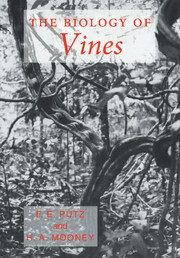Book contents
- Frontmatter
- Contents
- List of contributors
- Foreword
- Preface
- Acknowledgements
- I INTRODUCTION
- II CLIMBING MECHANICS AND STEM FORM
- 2 Anatomy of vine and liana stems: a review and synthesis
- 3 Biomechanical studies of vines
- 4 Structural responses to stem injury in vines
- III VINE PHYSIOLOGY AND DEVELOPMENT
- IV COMMUNITY ECOLOGY OF VINES
- V ECONOMIC IMPORTANCE OF VINES
- Taxonomic index
- General index
2 - Anatomy of vine and liana stems: a review and synthesis
Published online by Cambridge University Press: 05 November 2011
- Frontmatter
- Contents
- List of contributors
- Foreword
- Preface
- Acknowledgements
- I INTRODUCTION
- II CLIMBING MECHANICS AND STEM FORM
- 2 Anatomy of vine and liana stems: a review and synthesis
- 3 Biomechanical studies of vines
- 4 Structural responses to stem injury in vines
- III VINE PHYSIOLOGY AND DEVELOPMENT
- IV COMMUNITY ECOLOGY OF VINES
- V ECONOMIC IMPORTANCE OF VINES
- Taxonomic index
- General index
Summary
Introduction
In the 19th century, the work of Westermeier & Ambronn (1881) and Schenck (1893) initiated appreciation of the many ways in which stem and wood anatomy of climbing plants differs from that of self-supporting plants. During the first half of the 20th century, data on stem and wood anatomy accumulated in the form of systematic comparisons, as particular taxonomic groups were investigated. The present chapter, as well as others in this volume, attempts to review this literature and present a new synthesis of the characteristics of vines and how they are related to habit, function, and ecology. After Haberlandt (1914), interest in a synthesis between form and function lagged, perhaps mostly because experimental work in plant physiology of scandent dicotyledons was relatively dormant; the recent renewed interest represented by the work in this volume permits new syntheses. A review of anatomical data is presented here by way of showing what comparative anatomical patterns suggest in terms of function, and thereby what correlations can be demonstrated or may in the future be demonstrated.
Cambial variants and cambial activity
Since the pioneering work of Schenck (1893), Pfeiffer (1926), and Obaton (1960), there has been general appreciation that lianas and vines, much more frequently than self-supporting woody plants, are characterized by the presence of cambial variants (the term from Carlquist, 1988; ‘anomalous secondary thickening’ of other authors). At the outset, one must note that cambial variants are by no means unique to scandent woody plants.
- Type
- Chapter
- Information
- The Biology of Vines , pp. 53 - 72Publisher: Cambridge University PressPrint publication year: 1992
- 7
- Cited by



